Edited Words of Rob Monti taken from Boater Board Post following the Kipawa River Judicial Review and impending dissolution of Les amis due to court costs.
We got the money, Les amis is still functioning but....
You remember what the Judicial Review was all about – the big picture?
Navigability and its preservation - (which implicitly preserves rivers in their wild state and provides an underpinning of thriving ecosystems and a sustainable world).
At a minimum the concept of protecting navigability as that concept has been handed down to us over the centuries and is a concept that is the foundation of what has protected waterways and their ongoing navigability to the current day should be seen as a right that presumptively takes precedence over other competing rights. The right of navigability should only be encroached upon where the proponent of such encroachment can demonstrate, using objective and consensus based criteria backed by science (not petty politics or cronyism or labels like economic stimulus) that such encroachment or impairment is justified and is always done in a way wherever possible so as to exact minimum impairment.
The Kipawa case was the first real real opportunity for a whitewater organization to flesh out that discussion, in the context of a rapid that had been safely navigated for decades, had become an international draw to paddlers and was being eliminated at the stroke of a pen. Why? Is the choice the government made, the best choice? What went into the decision-making? What factors were considered? Who was consulted? What is being gained? What is being lost? What are the implications of not just the final decision, but the process by which the decision was arrived at?
I saw this as an important case. Too few agreed.
Nothing the government did surprised us in this case. The biggest and saddest surprise and part of the problem going forward is that the so-called boating community is lame. There’s a whole lot of talk but very few walk the talk. In the U.S. there is American Whitewater fighting the feds, getting dams busted up, getting releases, defending access.
We wanted a precedent. A precedent may take time coming. What has to happen first is people ( a whole lot of people) just need to recognize and agree that here was something worth saving. Could people mobilize around a river festival that has gone for decades is known far and wide and has publicized a gorgeous river with excellent first hand evidence of navigation. This case was about sending a wake up call and seeing who out there was even listening and how many people cared.
Save for exceptional individual bright lights: this so-called boating community proved to be just a theory. The “community” was expected to put a big shout out and make this a political issue but proved to be a pretty marginal subgroup in the end.
If that community is out there, it never really woke up. What needed to materialize didn’t. We had the first level hearing in the Supreme Court of Canada building. There was an opportunity to send a message. It didn’t happen. Well, maybe it missed that one and would show in the Federal Court of Appeal. No again.
Boaters couldn’t agree that this case mattered. Even less would dig into their pockets to contribute. Too many saw it as marginal and not worth the effort. Most failed to see it as the “thin edge of the wedge” that will embolden other interests and make damming other rivers with the stroke of a pen and ignoring the concerns of whitewater boaters that much easier. If boaters didn’t get it, then what possible chance is there to build a persuasive case that will convince the average citizen, a politician or a legislator that what you care about matters or should matter to the broader citizenry?
So the NWPA comes under attack and a demonstration was organized on Parliament Hill. Here was a real opportunity for boaters at the grass roots to come together, to make some noise and to celebrate the rivers they love in a show of mass support for river preservation. It was an extremely low effort investment required from the community to show you care about paddling rivers and want to keep paddling those rivers. All you had to do was show up. The Rupert is gone. Part of the Ashlu is gone. The Pet is being assessed for a hydro diversion. Anybody see a pattern? You want to see how a river gets saved, read up on the dam that was never built on the Franklin river in Tasmania and how support was rallied to the point where numbers reached 20,000 – in Tasmania! Something like 1200 people were arrested in protest and blockades. Ask yourself the question. How did they get so many people to care and why don’t enough care here?
So how many showed for the cause– maybe 50. Fifty! I can see how some might superficially dismiss the Kipawa case because ostensibly it was just about a dam. But surely you would care enough about other rivers in Canada to show up when it mattered right? Nope. That sent a very clear message about how much this issue resonates or doesn’t. More importantly it shows how many boaters will get their asses out of boats and move them to be a political force. Not showing up does send a clear message. The community did a good job of showing industry and politicos that they can keep on ignoring the arguments because when push comes to shove, some would rather stay home or just go boating.
Stopping the loss of rivers and protecting rapids will only happen with cohesion, dedication, hard work and persistence. Most importantly, if there is a ww boating community, it has to wake up. It has to mobilize en masse. It can’t sit back thinking one, two or 10 people will get the job done while the rest benefit without having to lift a finger. There has to be a critical mass. Until there is ww boaters will just be brushed off with form letters and ignored. Based on what I’ve seen and what I continue to see on this board (with stunts like Pete’s) I’m pretty sure it will not happen anytime soon. Most here are just looking to be entertained.
Whitewater boaters in this country will continue to lose and lose and lose until people get their s@#(t together, roll up their sleeves and do some real work. At least boaters in the U.S., through American Whitewater got it right. At least I live close to the Adirondacks, so I’ll always have place to paddle protected rivers. But it saddens me as a Canadian, a paddler, a father to see the places that make this country not just great, but spectacular and a draw around the world, being diminished and pilfered away for short term gain of very few at the expense of Canadians generally through a combination of shortsightedness and the indifference of the silent and apathetic majority who are just letting it happen.
Subscribe to:
Post Comments (Atom)
Useful Links
- Mount Gox - Bitcoin exchange
- Reggie Middleton's Rapier Analysis
- Ontario Rivers Alliance
- Geodesic Dome Construction
- Canadian Disaster Preparedness
- Globe and Mail
- Chris' The Weekly Telegram
- Michael Rupert of CollapseNet
- Max Keiser
- Nicole Foss Blog - the automatic earth
- Peak Moment Discussions
- Scotia Mocatta Bullion Store
- Dimitry Orlov - Peak Moment Discussions
- Jims's ISFCR Blog
- Jenny Right Side Blog
- Scott Sorensen
Alternative Energy Sites I like
The Queen is not amused!
http://www.ispeakforcanadianrivers.ca/
The Ashlu river: it could happen to you

Whitewater Ontario

Working Hard to Protect Canada's Paddling Resources
Whitewater Ontario - Mission Statement
It is Whitewater Ontario’s mission to support the whitewater paddling community through the promotion, development and growth of the sport in its various disciplines.
We accomplish this through the development of events, resources, clubs, and programs for personal and athletic development, regardless of skill level or focus, to ensure a high standard of safety and competency;
We advocate safe and environmentally responsible access and use of Ontario’s rivers.
Whitewater Ontario is the sport governing body in the province, and represents provincial interests within the national body Whitewater Canada and the Canadian Canoe Association
http://www.whitewaterontario.ca/page/mission.asp
Kipawa, Tabaret, and Opemican
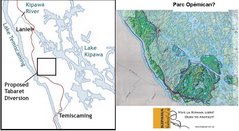
If Hydro Quebec is not actively pursuing Tabaret what is that bite out of Opemican for?
Kipawa Dam: After

Laniel Dam at 2006 Rally
Where is the Kipawa
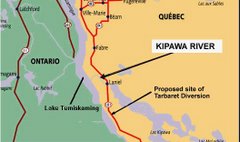
Kipawa flows into lake Temiskamingue, running from Kipawa Lake, under hwy 101 in Quebec
Kipawa Dam

laniel dam at 2004 River Rally
Tabaret is a Bad Idea
About the Kipawa
The best thing paddlers can do to help the cause of the Kipawa:
1. attend the rally and bring others including non paddlers to attend and buy beer and have fun
2. write your MP /MNA and raise the issue and post your objections -1 letter = 200 who didn't write
3. Write Thierry Vandal the CEO of Hydro Quebec strongly opposing the 132 MW standard decrying the use of "diversion" as the most environmentally inappropriate method of power production
4. Write Jean Charest, Premier of Quebec protesting that either the algonquin or the tabaret project will eliminate all other values on the Kipawa River by turning it into a dry gulch.
5. See if you can get other allied groups interested by showing your own interest, ie the Sierra Defense Fund, Earthwild, MEC, and so on.
6. Demand further consultation
7. Currently we are at the point where we need to sway public opinion and raise awareness.
However, if all else fails, don't get mad, simply disrupt, foment, and protest . The Monkey Wrench Gang.
Have you read Edward Abbey?
Important Addresses
CEO,Hydro Québec, 75 boul René Levesque, Montreal, P.Q., H2Z 1A4Caille.andre@hydro.qc.ca
The best thing paddlers can do to help the cause of the Kipawa:
1. attend the rally and bring others including non paddlers to attend and buy beer and have fun
2. write your MP /MNA and raise the issue and post your objections -1 letter = 200 who didn't write
3. Write Thierry Vandal the CEO of Hydro Quebec strongly opposing the 132 MW standard decrying the use of "diversion" as the most environmentally inappropriate method of power production
4. Write Jean Charest, Premier of Quebec protesting that either the algonquin or the tabaret project will eliminate all other values on the Kipawa River by turning it into a dry gulch.
5. See if you can get other allied groups interested by showing your own interest, ie the Sierra Defense Fund, Earthwild, MEC, and so on.
6. Demand further consultation
7. Currently we are at the point where we need to sway public opinion and raise awareness.
However, if all else fails, don't get mad, simply disrupt, foment, and protest . The Monkey Wrench Gang.
Have you read Edward Abbey?
Important Addresses
CEO,Hydro Québec, 75 boul René Levesque, Montreal, P.Q., H2Z 1A4Caille.andre@hydro.qc.ca
Tabaret is a Bad Idea (Part Two)
Les Amis de la Riviere Kipawa is poised to use an application to the Federal Court to issue a Writ of Mandamus to ensure the Minster does what he is supposed to do, protect the public's right to navigate the water control structure at Laniel, Quebec using the Navigable Waters Protection Act. (see http://www.kipawariver.ca/)
In the now gutted Navigable Waters Protection Act lay the means by which the Minister of Transport could keep the public right of passage down our great Canadian Heritage, our rivers and streams which are threatened especially by resource corporations and power brokers such as Hydro Quebec.
These powerful entities continue to petition that 'this' river or 'that' stream is not navigable and therefore not protectable.
I don't say that dams and bridges should not be built, only that if they are, historical navigation rights should be considered and preserved by making reasonable accommodations for recreational boaters.
It is the Minister of Transport, in exercising the right to allow or disallow work on or over a navigable waterway is what keeps boats and recreational boaters plying our waterways.
To many recent cases launched in the Federal Court concerning the Navigable Waters Protection Act, most recently the case of the Humber Environment Group of Cornerbrook Newfoundland versus the Cornerbrook Pulp and Paper Company indicates that the important oversight is not being faithfully performed. Have we really come to the point now where we must say "such and such a stream is one foot deep, possessing so many cubic feet per second flow and so on?" The answer to this is... YES!
The honourable Mr. Justice John A. O'Keefe, ruled that it had not been shown that the river was navigable. How convenient was that to the Minister? But either the Minister of Transport acts to protect our rivers and streams as a public right or he does not and that means rivers and streams currently enjoyed by kayakers and canoists.
Enough of the cheating, and double-talk. Canadians! our rivers and streams are our own, lets urge the Minister of Transport and the our government to protect them.
Peter Karwacki
In the now gutted Navigable Waters Protection Act lay the means by which the Minister of Transport could keep the public right of passage down our great Canadian Heritage, our rivers and streams which are threatened especially by resource corporations and power brokers such as Hydro Quebec.
These powerful entities continue to petition that 'this' river or 'that' stream is not navigable and therefore not protectable.
I don't say that dams and bridges should not be built, only that if they are, historical navigation rights should be considered and preserved by making reasonable accommodations for recreational boaters.
It is the Minister of Transport, in exercising the right to allow or disallow work on or over a navigable waterway is what keeps boats and recreational boaters plying our waterways.
To many recent cases launched in the Federal Court concerning the Navigable Waters Protection Act, most recently the case of the Humber Environment Group of Cornerbrook Newfoundland versus the Cornerbrook Pulp and Paper Company indicates that the important oversight is not being faithfully performed. Have we really come to the point now where we must say "such and such a stream is one foot deep, possessing so many cubic feet per second flow and so on?" The answer to this is... YES!
The honourable Mr. Justice John A. O'Keefe, ruled that it had not been shown that the river was navigable. How convenient was that to the Minister? But either the Minister of Transport acts to protect our rivers and streams as a public right or he does not and that means rivers and streams currently enjoyed by kayakers and canoists.
Enough of the cheating, and double-talk. Canadians! our rivers and streams are our own, lets urge the Minister of Transport and the our government to protect them.
Peter Karwacki
Tabaret is a Bad Idea (Part Three)
10 Reasons WhyTabaret is a Bad Idea1) Tabaret is too big. The station is designed to useevery drop of water available in the Kipawawatershed, but will run at only 44 percent capacity.We believe the Tabaret station is designed to usewater diverted from the Dumoine River into theKipawa watershed in the future.
2) The Tabaret project will eliminate the aquaticecosystem of the Kipawa River.The Tabaret project plan involves the diversion of a16-km section of the Kipawa River from its naturalstreambed into a new man-made outflow from LakeKipawa.
3) Tabaret will leave a large industrial footprint on thelandscape that will impact existing tourismoperations and eliminate future tourism potential.
4) The Tabaret project is an aggressive single-purposedevelopment, designed to maximize powergeneration at the expense of all other uses.
5) River-diversion, such as the Tabaret project, takinglarge amounts of water out of a river’s naturalstreambed and moving it to another place, is verydestructive to the natural environment.
6) The Kipawa River has been designated a protectedgreenspace in the region with severe limitations ondevelopment. This designation recognizes theecological, historical and natural heritage value ofthe river and the importance of protecting it.Tabaret will eliminate that value.
7) If necessary, there are other, smarter and morereasonable options for producing hydro power onthe Kipawa watershed. It is possible to build a lowimpactgenerating station on the Kipawa river, andmanage it as a “run-of-the-river” station, makinguse of natural flows while maintaining other values,with minimal impact on the environment.
8) The Kipawa watershed is a rich natural resource forthe Temiscaming Region, resonably close to largeurban areas, with huge untapped potential fortourism and recreation development in the future.Tabaret will severely reduce this potential.
9) Tabaret provides zero long-term economic benefitfor the region through employment. The plan is forthe station to be completely automated andremotely operated.
10) The Kipawa River is 12,000 years old. The riverwas here thousands of years before any peoplecame to the region. The Tabaret project will change all that.
Problems on a local River?
- There is more to do as well but you have to do your research and above all, don't give up.
- IN the meantime prepared a document itemizing the history of navigation of this spot and its recreational value. Use the Kipawa river history of navigation as a guide: see www.kipawariver.ca
- Under the Ministry of Environment guidelines you have a set period of time to petition the change under the environmental bill of rights, you may have limited time to take this action. But it involves going to court for a judicial review of the decision.
- 4. contact the ministry of natural resources officials and do the same thing.
- 3. contact the ministry of the environment and determine if they approved the project
- 2. determine if the dam was a legal dam, approved under the navigable waters protection act.
- 1. research the decision and timing of it to determine if an environmental assessment was done.
Minden Ontario
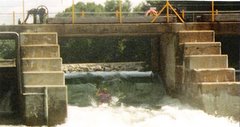
Gull River Water control at Horseshoe lake
A History of Navigation on the Kipawa River
Prior to the environmental assessment there was no signage at the Laniel Dam
T-Shirts Area: These are available now!

Send $25 and a stamped self addressed envelop for the Tshirt, and for the bumper sticker, a stamped and self addressed envelope with $5.00 for the bumper sticker to Les Amis de la rivière Kipawa, 80 Ontario St., Ottawa, Ontario, K1K 1K9 or click the link To purchase a Les Amis "T" contact Doug with the following information: Number of shirts:Sizes: Ship to Address: Method of Payment: cash, cheque and paypal, Shipto address:
Bumper Stickers Now Available

Get your bumper sticker and show your support for the Kipawa Legal Fund ! - send $5.00 in a Stamped, self addressed envelope to: Peter Karwacki Box 39111, Ottawa, Ontario, Canada, K1H 7X0
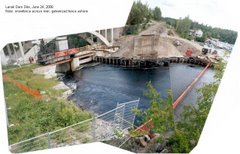

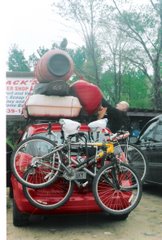
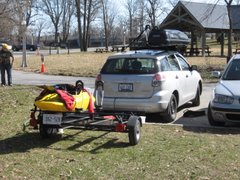

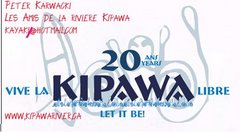
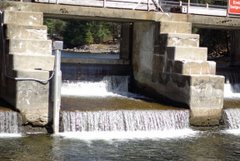


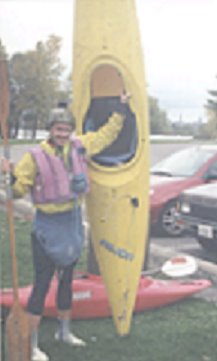



No comments:
Post a Comment